| |
|
 |
Since 2.5G, mobile phones have gradually evolved into a multifunctional platform of video, data, entertainment, commerce, and payment functions, instead of providing voice service only.
In the 3G era, the network upgrade has proved to be a stimulus to mobile phones multimedia applications. The baseband processor has failed to satisfy the increasing needs of multimedia applications. This new trend calls for the creation of multimedia application processors.
In fact, creating a multimedia application processor is much easier than creating a baseband processor. For baseband processors, many factors must be considered: years of experience in operating communication protocol stack, power consumption, cost and volume. And considering the high patent fees and the high cost of R&D, the medium and small enterprises can hardly afford to create baseband processors. Now, the basic knowledge for multimedia application processor is video decoding and 3D acceleration technology, and quite a number of enterprises have this knowledge. Plus, as the R & D expenditure is quite low, and as the mobile phone market scale exceeds 700 million handsets, multimedia application processors have really bright prospects.
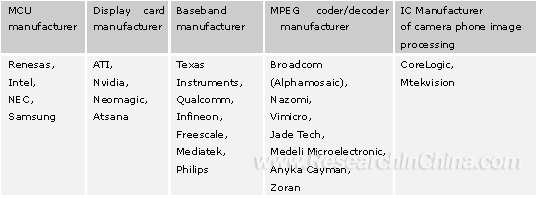
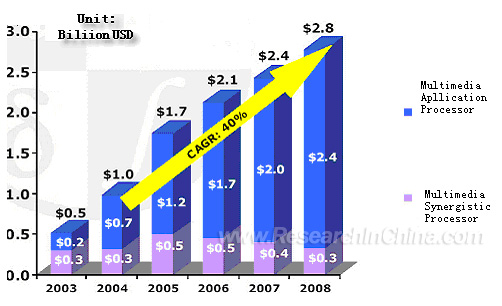
The figure above is the global market scale of multimedia application processor, which is expected to be up to USD 2.8 billion by 2008.
The additional applications of future mobile phones will not be limited to multimedia, but will also consist of Wi-Fi, UWB, A-GPS, bluetooth, ultrared, 3D game, E-payment, and security applications. The emergence of such applications also calls for application processors. In the early stages, application processors usually allowed camera control or back-end signal processing. Later on, with the emergence of music, film shooting and TV applications, the application processor became multifunctional and many low-end applications were integrated into the baseband processor.
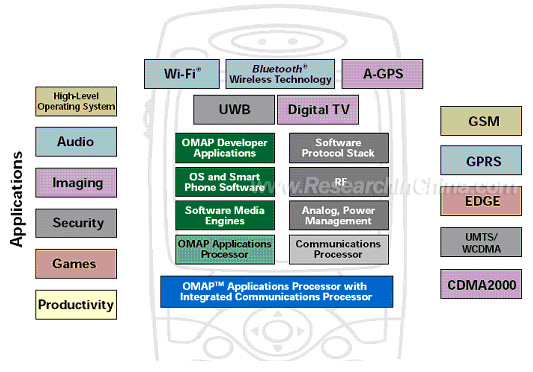
Application processor demand includes the following:
1、Performance, including multimedia processing and multi-task implementing performance
2、Cost, including chip cost, EMS memory cost and consumption
3、Power consumption, including standby and operation
4、Enlargement, performance dynamic allowance, developing-style operating system and JAVA support
5、Application development, compatibility between hardware and software, the third party support, design tools and support, services.
Application processors can be divided into 3 groups in term of designing, one is array processor with single ARM kernel, another is ARM kernel plus DSP, and the last one is gate-level logic circuit design. In addition, a few manufacturers apply a RISC structure.
The greatest merit of ARM kernel is its easy-to-build operation platform and good performance, while its demerit is the performance / power consumption ratio, which is inferior to DSP's. Consequently, ARM kernel is good at interlinking with softwares, and its high flexibility allows it to control multi-devices mobile phones. Meanwhile, DSP is good at fixed model calculating. The performance of ARM has much to do with the operation frequency: to reach high performances, clock frequency must be increased, which in turn leads to an increased power consumption. The DSP kernel of TMS320C55x, which is used in Texas multimedia processor, has a much higher efficiency than that of ARM11.

High Bit Rate DSP takes a long period of development and needs a lot of manpower and capital. Medium or small-sized enterprises don't usually develop HI-BIT DSP alone, but the array processor with ARM kernel is widely used. Display card makers have gathered plenty of experiences in graphic processing and are able to design multimedia application processors based on gate-level logic circuits.
Price list of common application processors
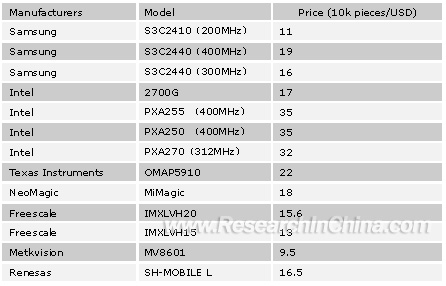
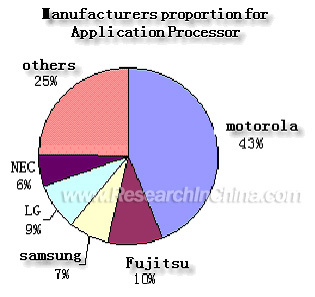
Total 69 models of mobile phones adapted application processor were listed in the report, as follows:
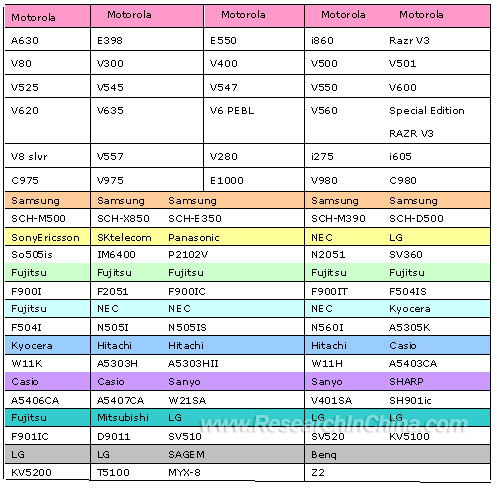
Motorola is the company launching the most models and at the fastest pace, and as many as 30 types processors were adopted. Nokia is designing the model that adopt ST Nomadik. Japanese manufacturers such as Fujitsu, NEC, Panasonic, Sanyo, Sharp, Kyocera and Hitachi tend to adopt the SH-MOBILE supplied by Renesas; Samsung attempts to try different application processors, LG chooses CoreLogic; SonyEricsson chooses Nexperia chip supplied by Philips for its smartphone - P800/P900/P910, and it tends to choose the application processor of PNX4008 also supplied by Philips. Siemens mobile phone division, after being acquired by Benq, is likely to choose the application processors supplied by Mediatek.
In the Chinese mobile phone market, domestic vendors pay more attention to cost savings than domestic brands. Therefore, Mediatek has gained a great market share. Even though Texas, Philips, Freescale are the main suppliers of foreign brands, obviously, in China market, Mediatek is the biggest competitor - a powerful and sophisticated rival who is supported by UMC.
|
|
|
|
|
If this report could not still meet your requirement, or
you have any comments or suggestions on it, please leave a
message to us.
|
2005-2007 www.researchinchina.com All Rights Reserved
| |
|
 |
| |
|
Since 2.5G, mobile phones have gradually evolved into a multifunctional platform of video, data, entertainment, commerce, and payment functions, instead of providing voice service only.
In the 3G era, the network upgrade has proved to be a stimulus to mobile phones multimedia applications. The baseband processor has failed to satisfy the increasing needs of multimedia applications. This new trend calls for the creation of multimedia application processors.
In fact, creating a multimedia application processor is much easier than creating a baseband processor. For baseband processors, many factors must be considered: years of experience in operating communication protocol stack, power consumption, cost and volume. And considering the high patent fees and the high cost of R&D, the medium and small enterprises can hardly afford to create baseband processors. Now, the basic knowledge for multimedia application processor is video decoding and 3D acceleration technology, and quite a number of enterprises have this knowledge. Plus, as the R & D expenditure is quite low, and as the mobile phone market scale exceeds 700 million handsets, multimedia application processors have really bright prospects.


The figure above is the global market scale of multimedia application processor, which is expected to be up to USD 2.8 billion by 2008.
The additional applications of future mobile phones will not be limited to multimedia, but will also consist of Wi-Fi, UWB, A-GPS, bluetooth, ultrared, 3D game, E-payment, and security applications. The emergence of such applications also calls for application processors. In the early stages, application processors usually allowed camera control or back-end signal processing. Later on, with the emergence of music, film shooting and TV applications, the application processor became multifunctional and many low-end applications were integrated into the baseband processor.

Application processor demand includes the following:
1、Performance, including multimedia processing and multi-task implementing performance
2、Cost, including chip cost, EMS memory cost and consumption
3、Power consumption, including standby and operation
4、Enlargement, performance dynamic allowance, developing-style operating system and JAVA support
5、Application development, compatibility between hardware and software, the third party support, design tools and support, services.
Application processors can be divided into 3 groups in term of designing, one is array processor with single ARM kernel, another is ARM kernel plus DSP, and the last one is gate-level logic circuit design. In addition, a few manufacturers apply a RISC structure.
The greatest merit of ARM kernel is its easy-to-build operation platform and good performance, while its demerit is the performance / power consumption ratio, which is inferior to DSP's. Consequently, ARM kernel is good at interlinking with softwares, and its high flexibility allows it to control multi-devices mobile phones. Meanwhile, DSP is good at fixed model calculating. The performance of ARM has much to do with the operation frequency: to reach high performances, clock frequency must be increased, which in turn leads to an increased power consumption. The DSP kernel of TMS320C55x, which is used in Texas multimedia processor, has a much higher efficiency than that of ARM11.

High Bit Rate DSP takes a long period of development and needs a lot of manpower and capital. Medium or small-sized enterprises don't usually develop HI-BIT DSP alone, but the array processor with ARM kernel is widely used. Display card makers have gathered plenty of experiences in graphic processing and are able to design multimedia application processors based on gate-level logic circuits.
Price list of common application processors


Total 69 models of mobile phones adapted application processor were listed in the report, as follows:

Motorola is the company launching the most models and at the fastest pace, and as many as 30 types processors were adopted. Nokia is designing the model that adopt ST Nomadik. Japanese manufacturers such as Fujitsu, NEC, Panasonic, Sanyo, Sharp, Kyocera and Hitachi tend to adopt the SH-MOBILE supplied by Renesas; Samsung attempts to try different application processors, LG chooses CoreLogic; SonyEricsson chooses Nexperia chip supplied by Philips for its smartphone - P800/P900/P910, and it tends to choose the application processor of PNX4008 also supplied by Philips. Siemens mobile phone division, after being acquired by Benq, is likely to choose the application processors supplied by Mediatek.
In the Chinese mobile phone market, domestic vendors pay more attention to cost savings than domestic brands. Therefore, Mediatek has gained a great market share. Even though Texas, Philips, Freescale are the main suppliers of foreign brands, obviously, in China market, Mediatek is the biggest competitor - a powerful and sophisticated rival who is supported by UMC.
|
|
|
|
|
2005-2006 www.researchinchina.com All Rights Reserved |
|
| |
|
 |
| |
|
1.Brief Introduction of Cell Phone Application Processor 2.General Description of Cell Phone Application Processor
2.1 Application range of application processor
2.2 Market scale of application processor
2.3 Basic structure of application processor
2.4 Cell phone group adopted application processor 3.Study on Cell Phone Application Processor Manufacturers
3.1 Qualcomm
3.2 Texas Instruments (TI)
3.3 Infineon
3.4 Freescale
3.5 ATI
3.6 Nvidia
3.7 Nazomi
3.8 Atsana
3.9 NEC
3.10 Renesas
3.11 NeoMagic
3.12 Zoran
3.13 Broadcom
3.14 ST
3.15 Philips semi
3.16 Mtekvision
3.17 Corelogic
3.18 Mediatek
3.19 Macronix
3.20 Chipnuts
3.21 Icmedeli
3.22 Jadechip
3.23 Fangtek
3.24 Vimicro 4.Introduction of MIPI League
4.1 Brief introduction of MIPI league
4.2 Member list and business range of MIPI league |
|
|
|
|
2005-2006 www.researchinchina.com All Rights Reserved |
|
| |
|
 |
| |
|
Global Camera Phone Shipment by Resolution, 2002-2008
Sales of Music Phones, 2003-2007
Sales of TV Phones, 2005-2010
Sales Trend of High,Medium and Low-end Handsets, 2003-2008
Global Multimedia AP (Application Processor) Market Scale, 2003-2008
Brand Distribution of 69 Mobile Phone Models Adopting Application Processors
Main Clients of Qualcomm
QCT's Product Roadmap
Qualcomm MSM6250 Internal Framework
Revenues and Growth Rate of TI's Wireless Division, 2002-2004
Market Share Distribution of Leading Wireless IC Manfacturers , 2003-2004
Revenue Distribution of TI's Products, 2001-2004
TI's OMAP2420 Internal Framework
TI's OMAP1510 Internal Framework
TI's OMAP-DM270 Internal Framework
Revenues and Gross Profit Rate of Infineon Wireless Division
Infineon RF Product Roadmap
Infineon Baseband Product Roadmap
Internal Framework of Infineon PMB7870
Internal Framework of Infineon PMB7870 (Upgraded Edition)
Internal Framework and Application Framework of Infineon PMB8876
Freescale Multimedia AP Product Roadmap
Internal Framework of Freescale MC9328MX1
Internal Framework of Freescale IMX31/IMX31L
Internal Framework of ATI IMAGEON2200
Internal Framework of ATI IMAGEON2300
Revenues and Gross Profit of Nvidia, Q4 03-Q1 05
Nvidia Multimedia Aplication Processor Specifications
Nazomi JA108 Application System
Atsana J2211 Internal Framework
Atsana J2211 Application System
Atsana J2211 Bus System
Atsana J2211 MMI Connection Interface
Internal Framework of NEC Multimedia AP MP211
SH-Mobile Roadmap
Internal Framework of Mobile 3A
Software Framework of Mobile 3A
SH-Mobile Multimedia Middleware Roadmap
Internal Framework of NeoMagic MiMagic5
MiMagic5 Application Framework 1
MiMagic5 Application Framework 2
Internal Framework of MiMagic6
Internal Framework of Zoran ER4521
Broadcom BCM2702
Internal Framework of Broadcom BCM2702
Internal Framework of Broadcom BCM2705
Department Revenues of ST Microelectronics, Q1 04-Q1 05
Nomadik Multimedia Appliaction Processor Roadmap
Internal Distributed Processing Mode of Nomadik Multimedia Application Processor
Internal Framework of Video DSP of Nomadik Multimedia Application Processor
Framework of Client-End API of Nomadik
Software Structure of of Nomadik Application Processor
STN8810 Applications
Sales Revenue and Gross Profit Rate of Philips Semiconductor, 2001-2004
Department Sales Distribution of Philips Semiconductor, 1Q 2005
Global Sales Distribution of Philip Semiconductor, 1Q 2005
Major Clients of Philips
Sales Revenue of Philips Nexperia Series, 2002-2004
Internal Framework of PNX4008 Multimedia Application Processor
Sales Revenue and Gross Profit Rate of Mtekvision, 2003-2006
Chip Shipment and Average Price of Mtekvision, Q1 2004-Q2 2005
Mtekvision Core Competitive Technology
Mtekvision Solution Framework
Internal Framework of Mtekvision MV319
Internal Framework of Mtekvision MV9313
Internal Framework of Mtekvision MV8601
Internal Framework of Mtekvision MV8602
Annual Sales and Net Profit of Corelogic 2003-2005
Corelogic Shareholders Structure
Corelogic Personnel Structure
Sales Distribution of Corelogic's Products, 2003-2005
Corelogic MAP Products Roadmap
Corelogic MAP Product Specifications
Corelogic HREA1.0 and 1.5 Interior Framework
Corelogic HREA TV Interior Framework
TV Part Framework of Corelogic HREA TV
Corelogic HREA 3D Interior Framework
3D Part Framework of Corelogic HREA 3D
Performance Comparison of Corelogic HERA, HERA TV and HERA 3D
Interior Framework of Corelogic VGA Series
Interior Framework of Corelogic DANA Series
Interior Framework of CL76S in Corelogic SARA Series
Performance Comparison of Corelogic CAP Products
Interior Framework of Corelogic ISP Products
Performance Comparison of Corelogic ISP Series
Clients of Corelogic
MediaTek Revenues and Gross Profit of MediaTek, 2001-2004
Personnel Structure of MediaTek
Sales Revenue of Vimicro, 2001-2004
Internal Framework of Vimicro VC0558
Internal Framework of Samsung S3C2410 Processor
Internal Framework of Samsung S3C24A0 Processor
CPU Distribution for Mainstream PDAs
Internal framework of PXA27X Series
Internal Structure of MIPI Alliance
Multimedia Application Processor Manufacturers Classification
Performance Comparison of ARM7, 9, 11 and TMS320C55X
Performance Comparison of The Three Handset AP Design Solutions
List of Wafer Plants for Application Processor
Price of Usual Application Processors
69 Models of Mobile Phones Adopting APs (excluding Intel’s)
Qualcomm Subsidiaries
Revenue Proportion of Qualcomm's Subsidiaries in First Half of 2005
Chip Shipment and CDMA Market Share of Qualcomm, 2002-2005
Performance of Qualcomm's Main Products
Mobile Phones Adopting Qualcomm's Chip
Structure of TI's High Performance Multimedia Application Processor
Handsets and PDAs Adopting TI's OMAP1510
Composition of TI's Traditional GPRS/GSM Platform
Performance of TI's OMAP Series Multimedia Application Processor
Infineon's Market Share in Baseband and RF Chip, 2001-2004
Infineon Mobile Phone Platform Introduction
Chip Sales and Profits of Freescale
Freescale Multimedia Application Processor Specifications
Revenues of ATI
ATI Multimedia Application Processor Specifications
29 Handsets Adopting ATI's Multimedia Application Processor
9 Handsets Adopting Nvidia's Multimedia Application Processor
Models of Mobile Phone Adopting Nazomi Multimedia Application Processor
Nazomi's Software Partners
32 Mobile Phone Models Adopting SH-Mobile Multimedia Application Processor
Specifications and Price of SH-Mobile Multimedia Application Processor
Financial Report of NeoMagic
Revenues and Profits of Zoran, 2003-1Q 2005
List of Companies Acquired by Broadcom
Revenues and Profits of Broadcom
Broadcom BCM2702 Features
Brief Introduction to Departments of STMicroelectronics
Department Profits of STMicroelectronics
ST's Chips for Nokia Mobile Phone Models
Mobile Phone Models Adopting Mtekvision Chips
Medeli Microelectronics Products
Fangtek Shanghai Product Series
Samsung's Mobile Processors Products
Mobile Devices Adopting Samsung S3C2410 Processor
Performance Comparison of Six PDA Processor Models
72 Models of Mobile Phone Adopting Intel’s Application Processor
Benefits and Fees for Members in Each Level of MIPI (Mobile Industry Processor Interface)
Members of MIPI
|
2005-2008 www.researchinchina.com All Rights Reserved
|



